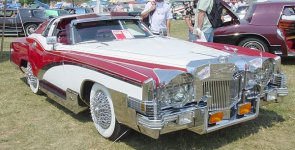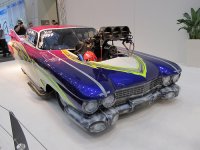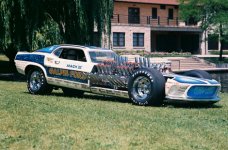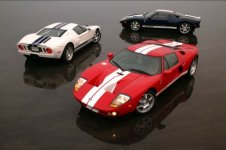I went to see the Terricota soldiers there and ended up seeing a lot more.... got vip treatment with the daughter of the cities chief of police as a guide. She said some sites she showed me and my friend had never been seen by westerners before. A city of 10 million and full of stories and beautiful areas. Saw a lot of people playing pool in their front yards - pool tables in the front yard! You got to go there if you are still in China. I brought art back that are from well known artists but who never sell outside of China. What a great country and history. Oooops. back to electronics....No not yet, someone else was asking me the same question only yesterday. Its on my mental list of places to visit for sure - I hear the dumplings are excellent.
Say what!? can you give that another go? It looks like English but I cant understand.CDs themselves are fine. What sucks, modern easiness of making bad records, and easiness of screwing good records down. That's why LP sounds better. Bad LPs did not survive.
It looks like English but I cant understand.
Wow ... This is an international forum. BTW, I can understand.
.....Phono is a hassle.... Think of it like a sports car.....
......................
You might think of digital as like the electric car. Quiet, hi tech, efficient.....
I have to disagree with you, John.
If we're drawing parallels between cars and playback systems, this is how typical vinyl PB systems would look like.
Apologies to other forum members for multiple posts and OT pictures!
Attachments
Yours would be similar to this.
Attachments
Last edited:
I've heard TO-3's sing when driving a resistive load.Of course, but them you have to excite the mechanical "circuit", that tiny slab of silicon needs a LOT of force to create the strain.
It's the emitter wire bond wire vibrating due to Lorentz forces.
I've also encountered punch through with diodes when a point defect is present on the copper anvils used with 2 and 3 inch diameter diodes, it causes high curretn at the point of pressure.
Also, I've seen emitter dip caused by wafer probing.. generally kills the device during BVceo and BVceo(sus) tests..
But for a bonded to substrate chip, the acceleration needed to modulate any parameters of the chip would flow the metal it's mounted to.
If they cut the can gently, it won't necessarily compromise the chip. It's simple enough to use a good glob top on the chip if it isn't there, or more to encapsulate the bonding wires if the chip is already covered.SAervice life in months at best if they did de-encapsulate the chip.
If they don't cover the aluminum wires or the chip properly, any reflow process is gonna raise havoc. I don't trust any flux with aluminum or chip level copper.
Glob top is pretty much used a lot of places now, especially overmolded chips.
I have noticed emitted sounds from transistors on other amplifiers too that I have overdriven.
George
The high harmonic content does make it hearable. Been there, done that. But it's generally the result of conductor movement doe to Lorentz.
I have read of thermal expansion coefficient mismatch causing "oil-canning" motion in T0-3 cans
Yah, they cause seal failures. As well as the helium high pressure bomb leak check procedures. They "oilcan" and allow helium through a crack, but when pressure is removed, the crack seals back up.
jn
TO 247 sing with resistive load as well, this is normal.
It may be the conductors around the device as opposed to the device itself. No way for me to know from a keyboard..
jn
Don't forget that no small contribution to getting those great Kraut cars and the like designed is because of the trench work to create highly polished turds like this
An externally hosted image should be here but it was not working when we last tested it.
Last edited:
For vinyl if you can find a 12 inch single pressing of a song you like usually you will be astonished at how good it will sound. Many times it's like hearing the tune for the first time. This goes for pre-90's stuff; I don't know what kind of digital madness may have been applied after that.
Say what!? can you give that another go? It looks like English but I cant understand.
Can't help, sorry. I have not seen Engrish-101 courses in colleges.
CD Tweaks
Don't get me started (too late...)
As Dir. of Engineering at a large CD/DVD replication plant, I have talked to many people with 'different' ideas of improving optical disc storage or data recovery. I do forensic data recovery and investigations into data integrity, and use several tools which unequivocally show data equivalence...or not. With over 6 billion pits on a 74-minute audio CD, if you decode the data twice and have zero E32 (uncorrectable) errors, it is almost impossible (1x10^11 for CD-DA, 1x10^17 for CD-ROM chance) that any single recovered bit is wrong. There are MANY, MANY ways (close to an infinite number, practically) to recover different data twice, really only one way to end up with the same data twice. For those nit-pickers who seize upon that microscopic chance of an error being propagated despite the error correction, let me say this: in 20 years of making CDs and DVDs, I have never seen it happen otherwise. If you have other experience, I would love to see it substantiated, otherwise it is mere mental masturbation.
Some of the 'idea' regarding data modification or enhancement include: green marker at the periphery, spraying the surface of the disc with a silicone oil suspension, suspending the disc in a magnetic field, recording pure PCM instead of EFM (Eight-Fourteen Modulation), mastering using an atomic clock instead of a TCXO, aerodynamic 'balance sheets' glued to the disc top, gold instead of aluminum metalize...etc.
I have performed analog pit-track signal analysis, data equivalence and TIA testing on replicated and recorded discs and found NONE of the above tweaks to correlate with improved data recovery with good discs and players. Gold metalize is great for longevity and corrosion resistance in a salt-spray environment, but has lower reflectivity per angstrom than does aluminum at 780nM. If any of these other tweaks actually made a difference, there is a MAJOR problem with the disc, player, or both.
I have had 'creative' interactions with analog audio designers who didn't have a clue as to the data storage methodology of a CD-Audio and wished to store the data directly as PCM, believing the EFM caused audible jitter. When I told them that ALL CD playback systems electronics began with a level-slicer and EFM decoder they told me I didn't know what I was talking about, because another replicator had made those discs and they played fine in their players. Great. So someone else lied (overtly or by omission) to them to get their business, something I could never do. I did not get the business.
The most common misconception I have to deal with when talking to audio engineers is that about jitter. Jitter of a CD pit-track is NEVER directly audible. If severe enough on the disc itself, it only leads to data errors, period. An analog pulse train like that optically recovered from a disc has only the one failure mode: jitter. All optical disc errors are defined as jitter (if you define jitter as the timing of the sliced transitions varying from an integral multiple of 'T', where T is the basic clock interval). A chunk of crap on a disc which momentarily obscures the data track merely causes a REALLLY long T. However, all data from the EFM decoder is then loaded into a buffer with a saw-tooth keep-full variable clock-rate, then error corrected, and then reclocked out to the SPDIF/AES/EBU port or other route to a D>A. If there is jitter in the output bitstream, it originates with the clock in the original A>D or D>A, not the disc.
Sorry to rant; I have had to explain this to (mostly) deaf ears hundreds of times over the last 20 years.
Cheers!
Howie
Howard Hoyt
Dir. of Engineering
AMI, LLC
but because it involves music, more happy in my (basically unpaid) role as:
CE - WXYC-FM
UNC Chapel Hill, NC
www.wxyc.org
1st on the internet
I'll never forget his patent on his "clarifier" gizmo which did nothing more than spin a CD in a static magnetic field.
In his patent, he literally claimed that doing so not only rearranged the data on the CD, but did data compression as well...
se
Don't get me started (too late...)
As Dir. of Engineering at a large CD/DVD replication plant, I have talked to many people with 'different' ideas of improving optical disc storage or data recovery. I do forensic data recovery and investigations into data integrity, and use several tools which unequivocally show data equivalence...or not. With over 6 billion pits on a 74-minute audio CD, if you decode the data twice and have zero E32 (uncorrectable) errors, it is almost impossible (1x10^11 for CD-DA, 1x10^17 for CD-ROM chance) that any single recovered bit is wrong. There are MANY, MANY ways (close to an infinite number, practically) to recover different data twice, really only one way to end up with the same data twice. For those nit-pickers who seize upon that microscopic chance of an error being propagated despite the error correction, let me say this: in 20 years of making CDs and DVDs, I have never seen it happen otherwise. If you have other experience, I would love to see it substantiated, otherwise it is mere mental masturbation.
Some of the 'idea' regarding data modification or enhancement include: green marker at the periphery, spraying the surface of the disc with a silicone oil suspension, suspending the disc in a magnetic field, recording pure PCM instead of EFM (Eight-Fourteen Modulation), mastering using an atomic clock instead of a TCXO, aerodynamic 'balance sheets' glued to the disc top, gold instead of aluminum metalize...etc.
I have performed analog pit-track signal analysis, data equivalence and TIA testing on replicated and recorded discs and found NONE of the above tweaks to correlate with improved data recovery with good discs and players. Gold metalize is great for longevity and corrosion resistance in a salt-spray environment, but has lower reflectivity per angstrom than does aluminum at 780nM. If any of these other tweaks actually made a difference, there is a MAJOR problem with the disc, player, or both.
I have had 'creative' interactions with analog audio designers who didn't have a clue as to the data storage methodology of a CD-Audio and wished to store the data directly as PCM, believing the EFM caused audible jitter. When I told them that ALL CD playback systems electronics began with a level-slicer and EFM decoder they told me I didn't know what I was talking about, because another replicator had made those discs and they played fine in their players. Great. So someone else lied (overtly or by omission) to them to get their business, something I could never do. I did not get the business.
The most common misconception I have to deal with when talking to audio engineers is that about jitter. Jitter of a CD pit-track is NEVER directly audible. If severe enough on the disc itself, it only leads to data errors, period. An analog pulse train like that optically recovered from a disc has only the one failure mode: jitter. All optical disc errors are defined as jitter (if you define jitter as the timing of the sliced transitions varying from an integral multiple of 'T', where T is the basic clock interval). A chunk of crap on a disc which momentarily obscures the data track merely causes a REALLLY long T. However, all data from the EFM decoder is then loaded into a buffer with a saw-tooth keep-full variable clock-rate, then error corrected, and then reclocked out to the SPDIF/AES/EBU port or other route to a D>A. If there is jitter in the output bitstream, it originates with the clock in the original A>D or D>A, not the disc.
Sorry to rant; I have had to explain this to (mostly) deaf ears hundreds of times over the last 20 years.
Cheers!
Howie
Howard Hoyt
Dir. of Engineering
AMI, LLC
but because it involves music, more happy in my (basically unpaid) role as:
CE - WXYC-FM
UNC Chapel Hill, NC
www.wxyc.org
1st on the internet
I have read of thermal expansion coefficient mismatch causing "oil-canning" motion in T0-3 cans
but these thermal expnasion based motions are not technically piezoelectric and not "reciprocal" Handbook of Acoustics - Malcolm J. Crocker - Google Books
doped Si in chips is also not piezoelectric - it can be piezoresistive, the resulting Vos modulation by package strain is discussed in Av 4000x strain gage amplification
We milled down a dip to the tops of the bond loops and got about 250uV Vos delta on an ordinary JFET op-amp with a titanium needle directly scratched across the surface. The real problem is dynamic/static friction effects from the differential thermal expansion (die/encapsulant). This led to polyaimd overcoat for all JFET products
Cheap R&D, I ground down the package on a grinding wheel, put it in a TEK op-amp curve tracer (remember those?) and called over the chief packaging engineer.
[JC, come over and try the twisty roads of hwy 49 with me in my modified ZR1 or modified CTS-V! I like high-performance in everything.... women, cars, art, video, audio. Why settle for less? ] -RNM
When all else fails back to the locker-room. BTW I think you need a Bentley at your age.
- Status
- Not open for further replies.
- Home
- Member Areas
- The Lounge
- John Curl's Blowtorch preamplifier part II





